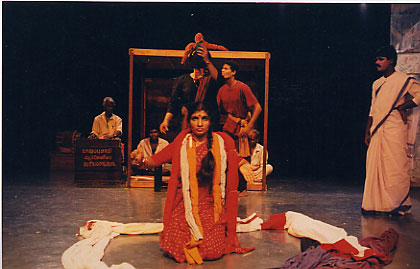Avanthi Meduri
Grant Period: Over three months
The Koothu-p-pattarai Trust has been a seminal force in the growth of a contemporary theatre consciousness in Tamil Nadu. In the last two decades, the group has mounted 33 productions and conducted an equal number of workshops.
In her doctoral dissertation, Dr. Avanthi Meduri recounts the sutured history of the devadasi and her dance. She examines what was lost, preserved, and concealed when this local practice - known as sadir or dasi attam - was renamed and reconfigured as Bharatanatyam, the national dance of India.
Last year Meduri, who is also a trained Bharatanatyam and Kuchipudi dancer, approached Koothu-p-pattarai (K-p-p), a theatre group in Chennai, and discussed the possibility of working with the group's actors and leader, Mr. N. Muthuswamy, towards a production based on her account of the social, political, and cultural history of Bharatanatyam.
While informing Meduri that her proposal for a theatrical production had been shortlisted for consideration by the advisory panel, programme staff expressed concern that her authorial voice appeared to have reduced K-p-p to a silent partner. However, Muthuswamy met with the members of the advisory panel and clarified that the project gave his group the important opportunity to apply their theatre techniques in a production that would involve musical patterning and choreography, and gain exposure to different audiences and performance contexts.
The panel recommended a three-month planning grant to give Meduri and K-p-p the opportunity to develop a clearer framework and shared vision for the proposed production. The decision on providing further support for completion of the project could be taken after reviewing the outcome of the initial dialogue and interaction between the collaborators. Meduri and Muthuswamy agreed to go ahead on this basis and the revised the proposal outlining a work plan for three months. Furthermore, they proposed to visualise scattered segments of the evolving piece.
Meduri sees the artistic project as having an enduring value because it could stand in for an absence, namely, the lack of a historical document in the performing arts that details the impact of colonialism and nationalism on cultural practices such as sadir. The impact of the project could be enhanced by documenting the work on video, so that it could be used for research and archival purposes and publishing the performance script and its dramatic visualization.
Collaborator: The Koothu-p-pattarai Trust



